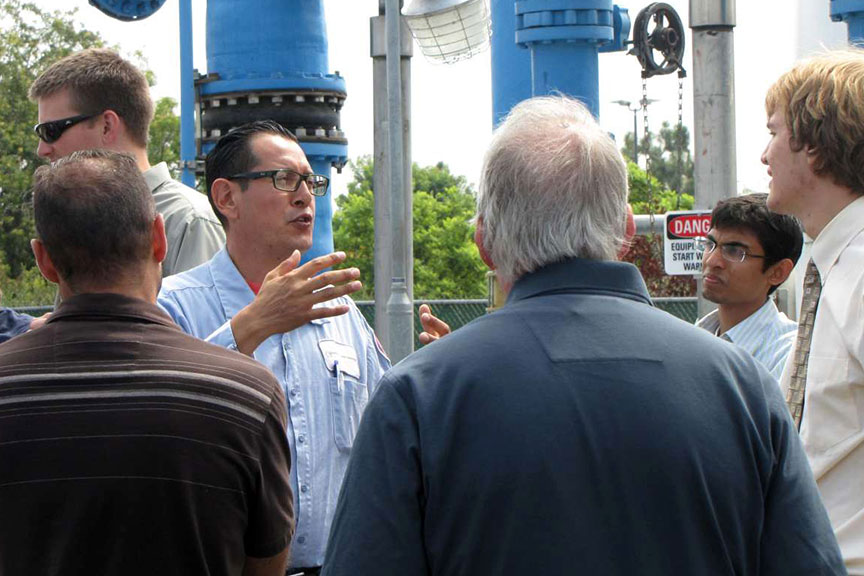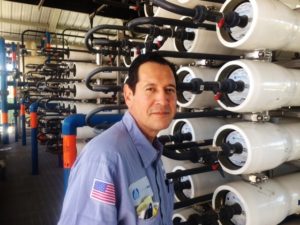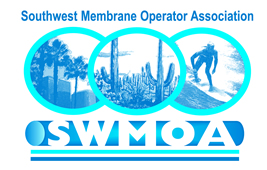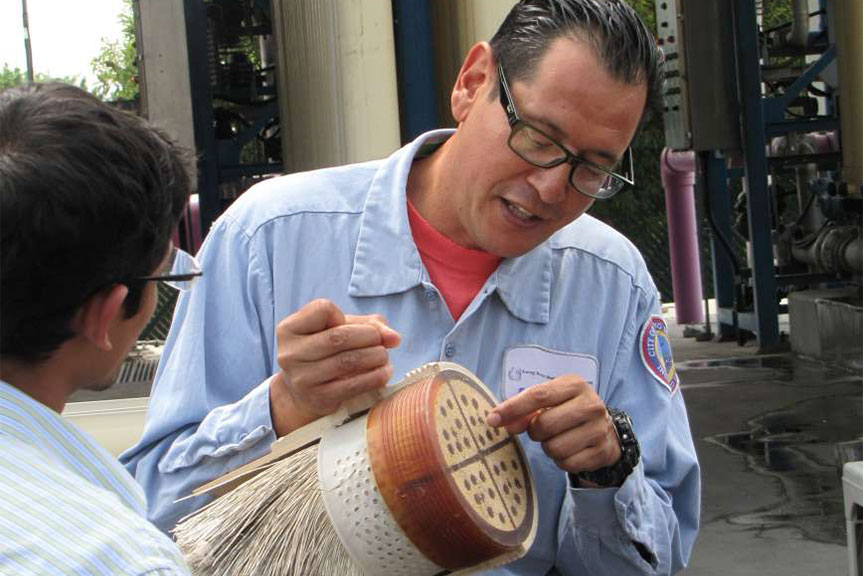
Long Beach Water’s Richard Salas has a passion for membrane treatment and operator training. (photo by Kent McKintosh)
About this series: Each month CWEA is interviewing an innovative thinker in the water profession. We’re asking each person “The future of the water profession is …”
Prior to becoming a water professional, Richard Salas worked for McDonald Douglas as a structural mechanic. “Working at McDonald Douglas gave me an appreciation of attention to detail,” Richard recalls. “The drawings are one side of the airplane only. To build the other side you flip them over and build a mirror image.”
“If you’re not paying attention that means you might drill holes in the wrong place.” Richard is proud to have participated in the building of the first 20 C17 planes produced by McDonald Douglas.
When a downturn hit the aircraft industry, Richard was encouraged by his family to look at water treatment as a stable form of long term employment.
Richard achieved his Water Treatment Operator Certification, and joined the Long Beach Water Department in October of 1995, in the position of Water Treatment Operator. The water treatment plant was undergoing an expansion from 25 million gallons per day (MGD), going from treating only well water, to a more intensive treatment process with a maximum capacity of 62.5 MGD. The technology being introduced at the plant was new to the industry.
Richard worked in the SCADA (Supervisory Control and Data Acquisition) control center. Changes in technology over the years has meant Richard is always learning something new throughout his career.
Today, Richard works at LB Water’s Leo J. Vander Lans Advanced Water Treatment Facility. He is also the Secretary and a long time member of the Southwest Membrane Operators Association (SWMOA).

Richard Salas Water Treatment Operator Long Beach Water Department Ground Water Treatment Plant
What do you believe is the future of the water profession?
The water profession is thriving. The biggest challenge we face in California, Nevada, Arizona and New Mexico, because we are mostly desert, and due to the recent drought, is to find or capture or recover existing water.
We need to upgrade to the new treatment technologies to take advantage of the water we have now.
Before, we would just discharge treated wastewater into the ocean. Now, because we have shorter allotments of water from traditional sources we are reusing water more efficiently. Instead of just discharging reclaimed water, we now use it in indirect potable reuse, to recharge aquifers, to water parks, or cleaning it in order to be able to use it as a seawater barrier to protect the ground water supply.
In the past we would use potable water as a seawater barrier in the aquifers. Now we use advanced treated water, from the Long Beach Water Reclamation Plant, to create that seawater barrier.
What is the mandate of the Membrane Operators Association?
 The Southwest Membrane Operators Association (SWMOA) is an affiliate of the American Membrane Technology Association (AMTA). Our mission is to enhance the knowledge of operators about advanced treatment systems such as membranes.
The Southwest Membrane Operators Association (SWMOA) is an affiliate of the American Membrane Technology Association (AMTA). Our mission is to enhance the knowledge of operators about advanced treatment systems such as membranes.
Most of the treatment comes down to Reverse Osmosis systems, where pure water is separated from contaminants.
Members of the Membrane Operators Association learn more about the analytical aspects of continuously monitoring the process. All water is different, so each plant will have different mineral content, suspended and dissolved solids. We use many different tests, such as ‘salt rejection’, where we test the conductivity of the water.
Conventional water treatment teaches operators to be concerned with certain specific aspects of the treatment process, while moving to an advanced water treatment system means they need to learn to interpret the data on a more continual basis.
What do membrane operators need to learn?
A membrane system can only push so much water through before it needs to be taken out of service. Pushing too much water through can lead to failure of the system or irreversible damage to the membranes. The water is pushed through the membrane under pressure, so at the beginning the system may only need 100 psi to process water, while towards the end it may need up to 200 psi to process the same amount.
Being constantly vigilant and knowing what type of cleaning is required — be it an acid cleaning, to dissolve minerals, or creating a high pH to remove biological contamination — will enhance the entire process. It is important to be able to be able to predict when the cleaning will be required, and using the analytical aspects of the process helps to project this downtime.
But every water source is different, so a lot of it comes down to experience. Most of this isn’t something that can be taught in a college course.
The Member Operators Association runs four to six workshops a year at different plants and we are currently running a training course for advanced treatment. The training course consists of four modules, each three days long. The four modules are:
The modules include plant tours and hands on troubleshooting. The members of SWMOA thrive on reaching out to other members. For instance, recently one of the members had an issue with snail shells, and was able to get suggestions for solutions from other members.
What are the current challenges in recruitment of water professionals?
Years ago we knew that there was going to be a mass of retirements. We were warned! Now we have more people retiring than entering the field. We try to recruit both from within the water industry and from outside.
A lot of the Water Agencies are challenging their existing workers to ‘do more with less’. But a lot of the workload is falling on the journeymen level workers. The journeymen need to be chameleon-like in adapting to change as the environment changes.

Richard provides a tour group with information about microfiltration membrane systems. (photo by Kent McKintosh)
What works for your organization in recruiting the next generation of water professionals?
The management at Long Beach saw the number of staff declining, and in 2016 started their first Water Academy. The initial 9 month course had 12 candidates, who were recruited at colleges, and by reaching out to veterans of the Armed Forces and the National Guard.
The candidates worked at the Water Treatment Plant and in distribution to gain a rounded knowledge of the water profession. They were taught safety training and math skills. At the end of the Academy, they were able to take their Water Certification exams.
In the end, most of them were hired by Long Beach, or by other agencies.
Long Beach is currently running another academy, this one focused on distribution and wastewater collection. We anticipate it will be as successful as the first academy.
Some of the candidates come to us with no experience in the water field, while others had some experience. But we always start off with safety training, and then move into different aspects of the job, from the physical requirements of putting a pipe together, to the mental aspects of SCADA systems.
All the candidates work under the supervision of a certified operator. As a result of doing the training, we’ve put together ‘SOPs’ (Standard Operating Procedures) for different areas. This not only helps us train new operators, but also makes us more efficient.
What benefits have you seen personally from your membership in associations such as CWEA and SWMOA?
I joined CWEA shortly after starting with Long Beach. Through my career I have taken advantage of their training courses and workshops.
Each month I try to attend a networking function, while also attending talks and presentations and the conferences.
Networking is so important in the water profession. Water treatment is becoming more interrelated and all water professionals need to take advantage of the opportunities to learn from others.
With the ongoing integration of drinking water and enhanced wastewater treatment, we’re finding a lot of cross over from what was traditionally wastewater knowledge into the water profession. As an example: Foam on the top of a process is something wastewater treatment professionals have had to deal with for years. Specialized cleaners for membrane plants can sometimes produce foam, which the ultrasonic transducers used traditionally for clean water can’t read through. The solution to the foaming problem came from professionals on the wastewater side.
What advice would you give to someone considering becoming a water professional?
Key is being a member of organizations such CWEA and SWMOA. But not just joining, be an active part of the association.
Start by being on a committee. See how each organization functions, and learn from that. Attend the conferences, and learn from others, and then gradually start sharing the knowledge you’ve gained with others.
Being a member of CWEA & SWMOA will give you a foot in the door of opportunity at other agencies. You can see how different agencies function.
Be willing to learn, and to keep learning. Technology is always changing. Learn to see, and be a part of the bigger picture.
Outreach is important. The more we outreach, the more the industry will grow. We need to get more people involved in the industry, both as consumers and as industry professionals.
Want to get others excited about a career in the water sector? Share the website CAWaterJobs.org with talented young people you meet.
To join SWMOA visit www.swmoa.org/membership/membership-application